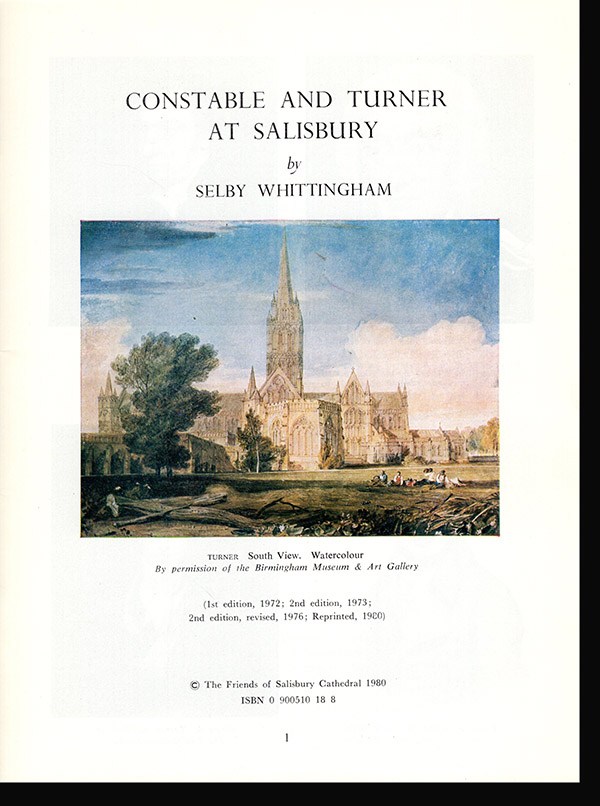

y first introduction to John Ruskin was aged 14 in April 1956, when I stayed at Batty's Farm, Coniston, within walking distance of Brantwood. With me were my father, whose family had known the Lakes for generations, two of the daughters of Bishop Lesslie Newbigin and their aunt, a neighbour of my grandmother at Huyton. Brantwood, however, did not make a great impression on me. I do not know if this was because it struck me, as it did Kenneth Clark, as being rather Victorian and plain inside. (Ruskin's lack of concern on that score was an additional factor distancing him from Whistler and Aestheticism). By contrast I have a vivid impression of Dove Cottage, deserted apart from an elderly gentleman, who, the woman at the desk told me, was the great-great-(great?) grandson of the poet and who looked passably like him. Daffodils bloomed and the lakes looked their best, a lasting place of enchantment despite the violent hayfever I suffered on that occasion.
At that time I was involved in a series of nine or so volumes of Ruskinian proportions by my mother which remained unpublished when she died two years later. These started with Shakespeare's life and went back to his history plays, the cycle Richard II to Henry V having been performed in 1951 for the Festival of Britain at Stratford-upon-Avon. We looked for portraits to illustrate this, following Thomas Carlyle's precept to do so, and this led to my doctoral thesis, completed in 1975, on “Realism in Mediaeval Portraiture.” In that I was encouraged to find an ally in Ruskin, who wrote provocatively that all individual portraiture is Gothic, the Classic peoples “rounding their chins by precedent” etc. Afterwards our late friend Jean Gimpel, author of The Cathedral Builders, equally provocatively said that Leonardo's achievements had been overhyped and that earlier mediaeval writers had done more for science than the Renaissance ones admitted.
Meanwhile in 1965 I joined Manchester City Art Gallery, which had a fine collection of Turners. A decade later fell the bicentenary of Turner's birth and the Whitworth Art Gallery mounted an exhibition of Turner watercolours and larger exhibitions were held in London. I put on a small display which included some copies of Turner watercolours made for the defunct Ruskinian Horsfall Museum. Reading the sad history of the Turner Bequest and disliking since the 1960s – as surely Ruskin would gave done? - the insensitive intermingling of Turners and Constables at the National Gallery, I was impelled to found the first Turner Society to campaign for an independent Turner Gallery such as Ruskin had hoped for. In this I found an early ally in an American Ruskinian in Paris, Robert Walmsley, Another who joined the society's committee was Alan Cole, who collected Ruskiniana and has a book on Ruskin awaiting publication. James Dearden also joined the committee for a while.



In this campaign I felt some affinity with Ruskin as also with my mother, who had been an active Conservative, while also a rebel against its championship of Appeasement and of the narrow Orange Order Protestantism to which it was bound in Liverpool. As an only son of a doting family I shared the benefits and disbenefits of that situation experienced by Ruskin.
I revelled in Ruskin's writings, less his long justification of Turner's style in Modern Painters than in the shorter works, copies of which then filled second-hand bookshops. And also in Praeterita, I sympathising with the writer's self-portrait. And then there were the concluding paragraphs of the introduction to the Notes on his Turners, dated “Brantwood, 12th February, 1878”, beginning “Morning breaks as I write, along these Coniston Fells ...”, words which have always moved me greatly.
So back to Coniston, I have revisited Brantwood, of course, but never seen Monk Coniston, home of the Marshalls who owned the Turner Burning of the Houses of Parliament now at Cleveland, whereas the one at Philadelphia, which had been owned by Holbrook Gaskell, partner of James Nasmyth, had been sold by his family by mistake, according to Ernest Gaskell, a lifelong friend of my father. Nor have I seen Tent Lodge at Coniston, where once resided Edward Swinburne, son of Turner's patron and father of the poet. John Browne-Swinburne posted me a letter from Turner which was published in Turner Society News, the editor wrongly identifying the recipient as Edward the son of Turner's patron instead of Edward the artist brother. Lord Lloyd of Kilgerran liked to relate that he had stayed at the The Pines, 11 Putney Hill, where the poet grandson lived in a slightly scandalous manner with its owner, Theodore Watts-Dunton. 5 July 2019.
PS The critic and curator Frank Rutter was born at 4 The Cedars, Putney, in 1876 and in Since I was Twenty-Five (which contains an amusing account of a philistine provincial English art gallery) preserved a faint memory of Ruskin calling on his father, Henry, who was Ruskin's solicitor until they fell out. The grandfather was the “safe sound lawyer” of Ruskin's father who helped persuade Ruskin to resign as Turner's executor. Frank (the subject of a long Wikipedia entry) studied Hebrew at Queens' College Cambridge in exactly the same years as my maternal grandfather was there studying theology. Apparently Frank's banjo playing made him popular. My grandfather, who was eleven years older, more seriously led a debate on church disestablishment in the college debating society and died some months before I first visited Brantwood. I have a photograph I took of him in 1949 encountering another contemporary while paying a visit to Queens'.
Last modified 5 July 2019